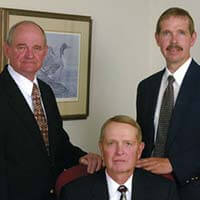The Beginning

The Dadant family has been interested in beekeeping for over 180 years. The founder, Charles Dadant, was born in 1817 in Vaux-Sous-Aubigny, a small village in eastern France, the second of seven children born to a small village doctor. He became interested in bees as he helped a neighboring priest remove honey from straw skeps at the early age of 12. Disillusioned with the business possibilities in France, he decided to accept an invitation of an old friend Mr. Marlot, then of Basco, IL, to come grow Champagne grapes and raise bees. In 1863, at the age of 46, he emigrated from France to America and settled in Hamilton, Illinois. The growing of grapes here did not prove to be lucrative so he abandoned them in favor of honey bees. By the end of the Civil War, Charles had nine colonies of honeybees, and traveled with his young son, C.P. Dadant across the Mississippi River to sell honey and beeswax in a neighboring town. His interest in making quality candles grew from his love and knowledge of beekeeping.
Charles was once the largest producer of extracted honey in America as well as one of the first to import queen bees from Italy on a large scale as he was unhappy with the common black or German bees he found here. He began a series of experiments on the size of hives and wrote a great deal on the large hive that appeared in both American and European journals. In 1872 he was offered the editorship of The American Bee Journal, but refused because of his unfamiliarity with the English language. He learned to read the New York Tribune by digging at the words one at a time with a pocket dictionary so that he could then translate it back into French for his wife.
Charles was a dreamer, a man with ideas and determination. He was the experimenter who became more widely known abroad than in his adopted country.
The Second Generation

When his father wrote home to France that he had settled on a 40 acre farm north of Hamilton that he had purchased from Mr. Marlot, the rest of the family packed their trunks and started for the unknown land that Camille Pierre (C.P.) had only dreamed of. Camille Pierre (C.P.) was only 12 years old when his father brought the family to America. When he first saw the Mississippi he couldn’t believe how magnificent it was in its beauty, almost equal to a lake. He described living in the small log house that his father had built as the happiest time in his life. Learning to read at the age of 4, Camille was more practical than Charles and was given the responsibility of carrying the purse strings at a very young age – he was the business man of the two. He built the business around his father’s knowledge and became a beekeeping leader. Every improvement and change for the better was made due to their own efforts and appreciated because of this. He would joke of a European business man and a little boy digging out oak trees and using a brush scythe to mow down all the hazel brush. The concept of a plow (pulling on the handles to go down and pressing down to bring it out of the dirt) went against all of his notions of mechanics. It was necessary for him to devote himself to the family farm and the sale of his father’s honey and farm products.
In 1871 when his father suffered from an asthma attack, it became necessary for him to take over the families 70 hives as well. Because there was no bridge across the Mississippi at this time, it was necessary for him to get up by 4:30 in order for him to get himself and goods to the ferry by 6:15. He considered himself lucky for many years that he was small because Captain Van Dyke never charged him for the ferry. He knew he was a grownup for the first time when the Captain held out his hand for a dime. He learned at a young age not to spend his money on candy or other desirable frivolities as it would be like throwing his money in the Mississippi for him and his family. He always got a good price for his wares when he sold them as he was a firm believer that “it pays to furnish good goods”.
In 1875 C.P. married Marie Marinelli and took her to the same log cabin his father had taken his family to. In 1878, they began manufacturing foundation for their own use and later, for sale. As the business grew, they improved upon manufacturing methods and helped to finance the invention of the Weed sheeting machine, still in use today. In 1885, the revision of Langstroth’s, “The Hive and the Honey Bee” was entrusted to them and four revisions appeared under their names from 1889 to 1899. Charles translated it into French and later it was translated into Italian, Russian, Spanish and Polish. Charles died in 1902 and C.P. proceeded to produce four revisions of the book himself.
In 1904, C.P. retired and built a home in Hamilton on what is now North 7th street overlooking the Mississippi. In his retirement he became a community leader helping to establish banks, the library, and was one of five to bring about the building of the dam between Hamilton and Keokuk. On his retirement, as he watched his three sons take over the business he stated; “So we have reared a family of beekeepers. Now they can speak for themselves and we can take a back seat and watch them work.” In 1912 however, his love of the honey bee beckoned to him once again. He assumed publishing of The American Bee Journal which has been published in Hamilton ever since. His goal was that the journal be the “finest publication on bees and beekeeping in the world.” Camille Dadant passed away in 1938.
“So we have reared a family of beekeepers. Now they can speak for themselves and we can take a back seat and watch them work.” – C.P. Dadant
The Third Generation

Three out of seven children born to C.P. were sons. They each graduated from the University of Illinois. Louis in mechanical engineering, Henry in civil engineering and Maurice in business administration. They all returned after college to help their father with the business. The business had been named Charles Dadant and Son. They were in the process of changing the name to Charles Dadant and Son and Grandson when Charles died in 1902. They eventually altered it to Dadant and Sons as each son began to return to join the business. In 1924, they moved the business off of the original family farm into a tire factory in town where the company continues to house its corporate office today.

They incorporated in 1948. Louis spent a number of years managing the bees and plant production. He later turned his attention more to sales of beekeeper’s supplies and the purchase of crude beeswax for comb foundation. Henry devoted his attention to plant problems and development. In 1921, he invented crimp-wired foundation. This foundation was received enthusiastically and the business grew to new levels. Maurice devoted his time to The American Bee Journal and the business in general. All three worked closely with bees.

Under this generation came the introduction of the Dadant hive, and many advances in the business of selling and providing beekeeping supplies. In following with the custom in France and with their father and grandfather, each of the three agreed they would bring a son or son-in-law into the business. It was during this transition that the business added the line of candles for the Catholic church. The introduction of gilt-edge foundation and the necessity of manufacturing woodenware also became apparent in this era.
The Fourth Generation

The first of the fourth generation to appear was Henry’s son-in-law, Roy Grout. The second was the son of Louis, James, and later the oldest son of Maurice, Robert Dadant. After World War II, James found other interests and the second son of Maurice, Charles, joined in 1946. This era saw the firm emerge as a modern and complex industry with a wide variety of interests. In 1963, as part of their Centennial celebration, a plastic-base foundation, Duragilt, was introduced along with a new revision of “The Hive and the Honey Bee”. In 1966, Charles Dadant assumed his position as president of the company. “Chuck” was a visionary and loved to try new products and methods of marketing.
Under his tenure as president, the company grew with the addition of 10 branch locations, a metalware plant in Dallas City, IL., a woodenware plant in Polson, MT and a new candle factory in Kahoka, MO. In the early 1950’s, he encouraged his good friend and co-worker Dr. G.H. (Bud) Cale to develop a hybrid bee breeding program which successfully developed the first commercially available hybrid queen bees known as the Starline and Midnite Hybrids.
In 1990, Charles turned the leadership over to his nephew Tom Ross and his two sons Tim and Nick Dadant. A good friend and beekeeping associate once described Chuck as someone who spoke softly but was listened to carefully. He was known to not take big jumps, but wisely a step at a time.
The Fifth Generation


This generation consisting of Tom Ross, Tim Dadant and Nick Dadant continues to succeed in meeting the challenges of growing the company in the beekeeping industry. Tom Ross oversees the religious line of candles, Tim Dadant guides the decorative candles and Nick Dadant monitors the beekeeping supplies. All three actively participate in the general running of the business. They have overseen another revision of “The Hive and Honey Bee” in 1992 and continue to publish the monthly magazine The American Bee Journal. Dadant & Sons houses one of the largest private libraries of beekeeping literature.
The Sixth and Seventh Generation

With the recent addition of Gabe Dadant (6th generation) and Matt Ross (7th generation) to the company, the family tradition will continue well into the future. Both of these young men are learning the different aspects of running the business. The company continues to remain the largest manufacturer of beekeeping supplies and is still a believer that “it pays to furnish good goods.”